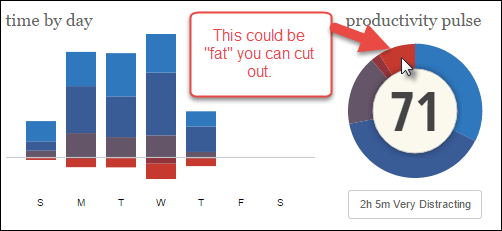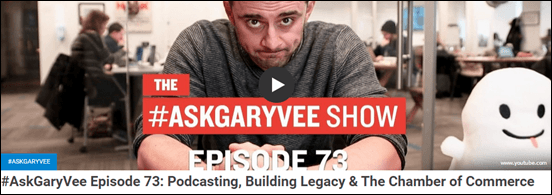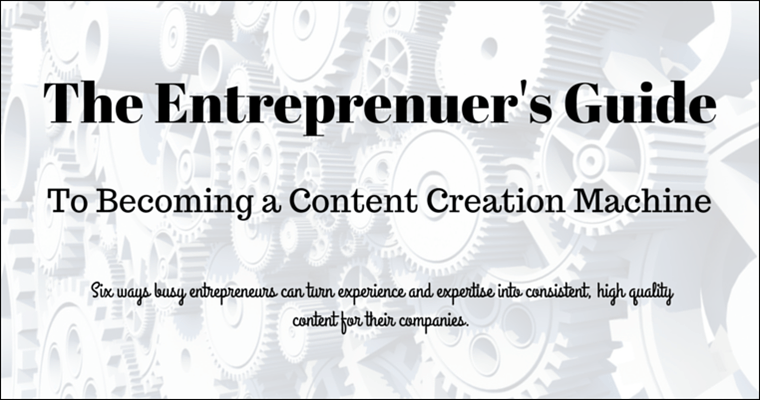When my company works with clients on content strategies we always start by asking about internal resources – who could create content inside your company?
A common answer to this question goes something like this:
“Well Jane, the CTO, is the real expert – she speaks at all of the conferences and has been featured in the New York Times a bunch and has a ton of really great insights on the industry – but she’s just so busy. So Billy the intern is writing a post a week. We can probably have him do more if that would help?”
Prolific interns can hugely help with content creation and promotion, but unlocking a consistent expert voice (or voices) can have a transformative impact on your company’s marketing efforts.
In this post I’ll walk through some specific tactics and strategies for getting great content out of a busy entrepreneur or C-level executive.
Carving Out SOME Time
I’ll go over some specific things you can do to get more content created in a limited amount of time later in the post, but as with any productivity improvement, you can learn how to do something faster and better, but you still have to do it. You need some time to actually dedicate to content creation efforts.
If you’re here reading this, you probably believe in the importance of content, so I won’t spend time making the “case for content” (it’s been done a lot if you still need incentive), but I will give you a few specific tips for finding more time in your day.
Identify the Least Productive Chunks of Your Routine
A friend of mine worked at a large company where they had an annual process where they would measure everyone based on certain performance metrics, and would lay off the bottom 5% of performers every year (even when they were aggressively hiring and expanding). You can probably do something similar to this with your daily routine.
Use a tool like RescueTime to monitor your activity. After a few weeks (or even a week) you’ll have a really specific look at where you spend your time. There’s probably a chunk of time every week that you can eliminate either by delegating that time or just spending zero to very little time on that task. Then, structure your day so you’re dedicating some time to writing and thinking, ideally at the best time to write and get ideas for you.

“Making the time” is really the most important productivity hack of all, but lots of other folks have some other great tips for making yourself more productive:
- Paul Jarvis wrote a great post about cultivating a writing habit when you run a business
- My old company WordStream partnered with BuzzSumo to share some great “content hacks” in this webinar
- Neil Patel shared a great, in-depth look at his process for writing 8 blog posts a week while running two companies
- Alex Hillman had a great post on “finishing your drafts” as well
But what if you’re “not a great writer” and you really do have a very finite amount of wasted time in your RescueTime reports? Let’s look at some specific tactics you can use to “speed up” your quality content creation process.
1. Create a Multi-Faceted “Idea Net”

When you’re on the treadmill, on a walk, in your car (though, drive safely) you might be able to generate a quick outline of an idea for a post. This can be particularly helpful if you’re having trouble carving out a dedicated hour to sit and write in front of a word processor. I use Evernote for these types of tasks, so I’ll talk about that specifically, but you can also use similar apps and/or piece together a few different apps you like that serve some of the same purposes:
- Start talking and use Evernote’s talk to text feature to get your thoughts down into a document that you (or even another member of your team) can flesh out
- If you’re someone who scribbles you can keep a physical file of that content, read it into a text file, or just save a screenshot of your thoughts to Evernote
- You can have a document in the cloud that you can edit from your phone/tablet/computer that houses your ideas that you can add to as well. If you’re using Evernote you can create a central repository (say a notebook) for all of your ideas and initial outlines, and “graduate” them into different folders or notebooks as they get to different stages (eg from ideas to outlines to full drafts), or you can use Google Drive or your cloud word processor of choice
You can customize this based on your own tendencies and workflow and preferences in terms of apps, but even if you just had Jane sending Billy a couple of outlines a week from talk-to-text activity at the gym or during her morning commute, you’d likely be getting a really interesting starting point for some more advanced, expert level content.
2. Get a Content Resource to “Interview” Your Senior Folks Via Email or Audio/Visual
If you have access to an intern or a more junior resource (either inside your company or as a contractor) one “hack” to get content out of your senior folks can be to email them specific questions about a specific topic or event.
Often as a founder or senior executive you’ll have a lot of thoughts about a specific process, topic, or news item, but you’ll find the blank page and formatting an entire article a bit intimidating. You can have a content resource on your own team or someone you hire externally help prompt you by asking a few questions and telling you they need a response by a certain time.
Make the time to answer as you would for an urgent email from your team, and answer thoughtfully on a consistent basis, and your blog will quickly have a consistent voice on industry topics and news. Bonus points if you can create an email distribution for all of the more experienced folks who would have an interesting take and get all of those folks to answer, too. Bonus BONUS points if you can get some other industry folks who would be interested in participating from other companies to agree to be added to that same email list – now you have some built-in distribution and extra content for each of these posts and you’re creating opportunities to create more “wins” for more people.
While it might be difficult to get yourself or senior folks in your company to craft an entire post or article from scratch, you likely burn through simple email questions from your team that require a paragraph or two in response. You junior resource can add some context to the post with background on the topic and links to other folks’ work on the topic, and then your email contribution adds the expert level color to the post. You can position this as getting quotes from your team on the topic, or if you’re the only one responding the post could be written or bylined as being written by you once you sign off on the topic.
3. Spin Content Into Different Formats and Different Platforms
Here again you can leverage a resource inside your company or a contractor (an editor or potentially a VA) to help you take a core concept and spin it out into different types of content. Let’s imagine I created a quick Evernote outline for this very post – what could I do with it to make my core concept work harder and create more useful content to get in front of prospects?
- I could re-purpose the post on LinkedIn or Medium to reach different folks
- I could create a great SlideShare presentation out of the content on my topic with the help of a design resource
- I could talk about the same general topic with another member of my team or industry colleague and turn it into video or audio content
And the inverse is also true – if I’m able to quickly and effectively create great video content, I could have a member of my team work with me to flesh that content out into written content (if you follow Gary Vaynerchuck’s excellent Ask Gary Vee Show and also see the content he’s publishing on his own site, on Medium, and in other places you’ll notice that there’s a lot of overlap in terms of topic and theme, and that he’s able to take one insight from his video Q and A show and spin it off into a lot of different types of content to reach folks in a lot of different places).
4. Try Formats Where You Can Apply Your Expertise in Real-Time
Vaynerchuck is a good example of a busy entrepreneur pushing out a lot of content not just because he’s spinning similar topics and insights into different content types on different platforms, but also because he is utilizing a great tactic in his video content: finding a way to leverage his experience and expertise consistently and in real-time. He doesn’t need to sit down with a blank cursor staring at him or do a ton of ideation and research to create new content: he’s turning questions (and by proxy, problems) from his audience into topic ideas, and then using his own experience and insights in real-time to create unique and useful content.

Even if you don’t already have an audience with a lot of questions for you, you can leverage the same Q and A format by:
- Answering questions that come in through sales or support.
- Finding questions your prospects are asking “in the wild” on forums or social networks – this can be something you task to a member of your team or a contractor.
- Crowdsource to your audience – they may not be asking you questions yet, but try asking your Twitter followers, emailing your list, or reaching out to any audience you have to find out what they’re struggling with and what you could help them with.
This “Ask X” format is something that a lot of different folks have had success with in different niches at different times throughout the history of content creation in different formats and contexts, so you could answer with audio, text, video – whatever you’re most comfortable with and are able to create the strongest content with.
Similarly, you can find other content formats where you’re able to respond to specific prompts and apply your expertise to add value for folks.
5. Live Audits, Teardowns, or Clinics
Just as answering a specific question is a great way to solve a specific problem and add value, critiquing / giving advice on the topic you have expertise in real-time can produce great content (others probably have some of the same problems and issues as the specific person or company you’re helping).
An example in the online marketing niche is site reviews or audits. Having a panel of experts review a few sites in front of an audience has been a conference staple (and favorite session) for years at search conferences. Search Engine Journal’s own ThinkTank Webinars take this approach to creating helpful video content. Conversion experts frequently leverage this technique as well by reviewing landing pages and offering feedback.

And you can venture outside the online marketing space and apply the same approach. In the online poker niche, there are poker websites that offer training by way of having top online poker players record their sessions and talk about their decisions. Aspiring poker pros pay a fee to see these experts play in real-time and offer commentary. There’s likely a way you can apply this to your own niche:
- In real estate? You could film yourself looking at a new listing and offering free recommendations for things they might do better (and highlight things they’re getting right).
- Have a home security company? Do a walk-through of a house in real-time and point out the different areas for vulnerabilities and mistakes the home-owner is making (probably make sure to anonymize the address).
- Sell board games? Get a game designer to sit down with the game and create a video walking through the game with common mistakes people make, rules they may not be aware of, fun alternative ways to play they may not know exist, lessons your company thinks kids should take away from the game.
There are a variety of ways to align the specific prompts for creating new content and tailor the format to whatever you are most comfortable with (talking in front of a camera, writing, etc.), meaning you can likely generate more great content than if you vaguely “try to write more often.”
6. Identifying Internal Documentation and Training You Can Share
There’s probably more great content that already exists inside your organization than you realize.
- Process Documentation: People have been open-sourcing their workflow for a long time. Sell a link building tool or services? Share your process for evaluating a link. Sell software to sales professionals? Making the training materials you’re already creating freely available is a great way to produce useful content at a minimal additional time-cost to you. The same can be said if you’re an information security company (how do you secure your own data? What rules do you impose on employees?), or you’re selling skin care products (can you turn some of your quality assurance documentation into tips or common risks with skin care products for your prospects?).
- Live Video Training: Along the same lines, you likely make presentations or have senior people delivering training talks and presentations. Why not have someone record them? Again, look here for the content that would be most useful to your prospects – sales software prospects might benefit from a presentation by your sales manager to her team. You explaining the most common mistakes companies make with data security or the problems with existing skin care products that you wanted to solve with your line could be compelling and useful content for prospects (and that video content could also be re-usable and easy to distribute internally to your team).
- Tools: Are there tools you have already built and use that you can open source? This might not be something you think of as “content,” but a spreadsheet template or simple widget you had your developers build might be extremely useful for your prospects (and a great way to get their attention).
The overarching point here is that there are a lot of ways to turn your expertise and experience into useful content. Identify your strengths (the type of content you’re best suited to create), take inventory of the areas where you use your expertise every single day to solve problems, and look for opportunities to leverage that same expertise and experience to solve problems for your prospects.
All screenshots in the post were taken on 2/19/2015 of rescuetime.com, evernote.com, garyvaynerchuk.com, and searchenginejournal.com.




